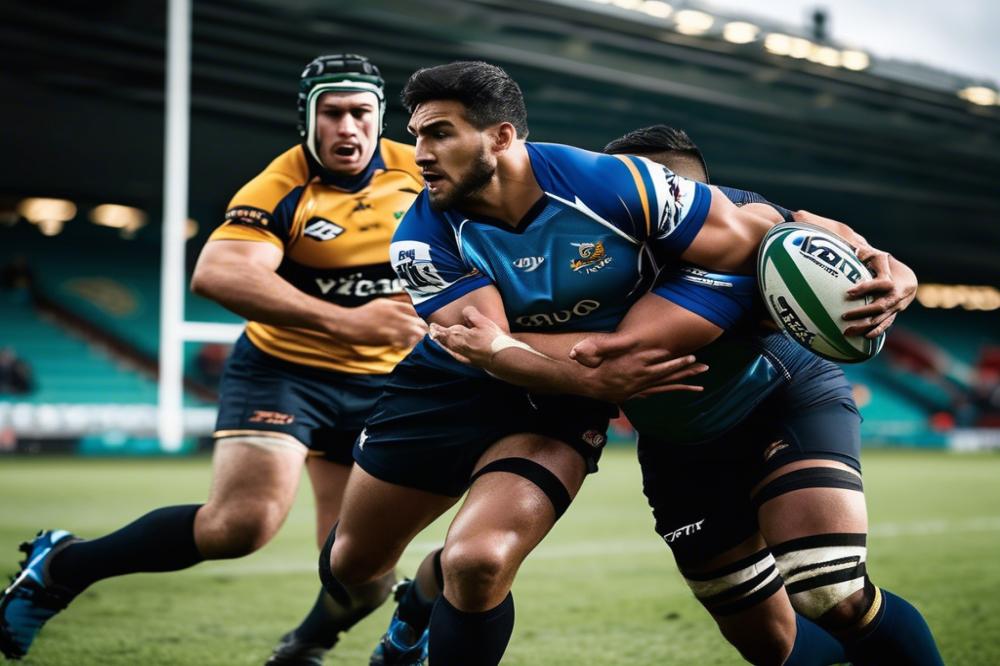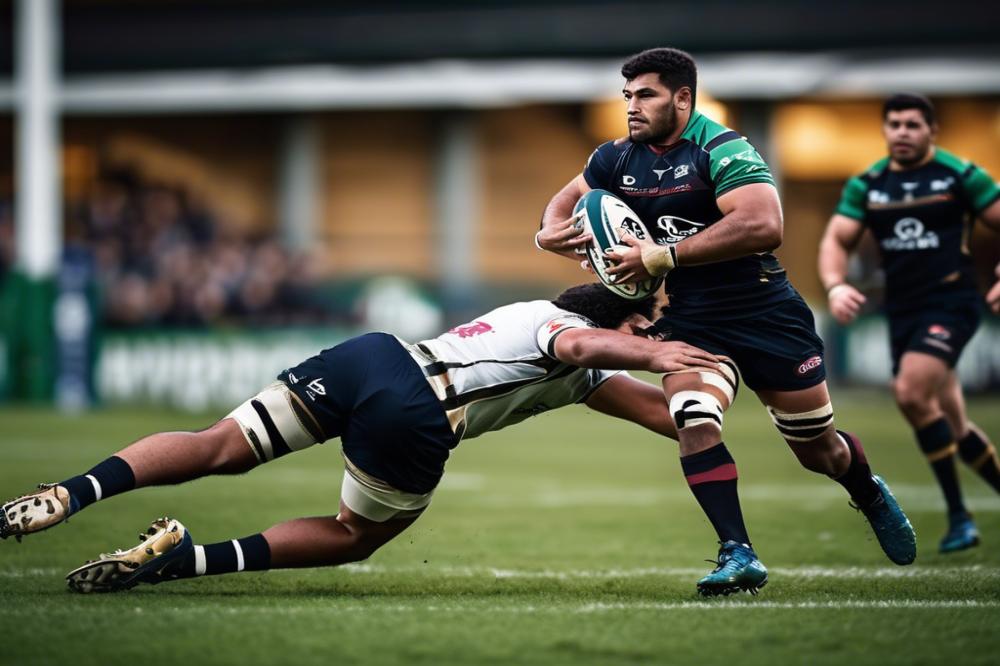Introduction
Rugby League is a captivating yet demanding sport. It is known for its physicality and intense gameplay. The sport involves powerful tackles and high-speed collisions. These elements are both thrilling and dangerous. Historically, injuries have been a major issue in Rugby League. Players often face threats of fractures, concussions, and sprains. The aggressive nature of the game contributes to these risks. Efforts to protect athletes have become crucial.
sports science plays a significant role in addressing these problems. Modern approaches focus on player safety as a top concern. Conditioning programs have been updated to include advanced techniques. Agility drills help players dodge harmful impacts. Tackling techniques are also crucial. They teach safe ways to bring opponents down. This reduces the likelihood of injury. Fitness programs aim to harden players and keep them agile.
Rugby League training has evolved significantly. It now incorporates comprehensive performance analysis. Experts examine players’ movements in detail. This data helps in creating effective conditioning plans. These plans focus on strengthening and flexibility. Strength training is crucial in building resilience. Players become less prone to physical harm. Effective concussion management is always a priority. Safety protocols monitor and aid recovery.
Rehabilitation methods have also improved. They help players get back to form after injuries. Thorough injury prevention strategies are crucial. They focus on minimizing risks through various practices. These ongoing changes are vital. They showcase an ongoing commitment to player safety and well-being.
Rugby League training: An Overview

Rugby League has always been a physically demanding sport. Traditionally, training focused on physical toughness. Players performed lots of endurance running. Long-distance runs built stamina. Strength training was heavy. Weightlifting improved muscle power. Tackling techniques were practiced extensively. Coaches prioritized contact skills over player safety. Injuries were common, but part of the game.
However, times have changed. Today, there’s a shift towards safer methods. Teams now value science and research. sports science has made its way into training routines. This introduces a more thoughtful approach. Conditioning programs are more targeted. Rehabilitation exercises are specifically designed. Recovery is as important as performance. Batting against injuries sets new priorities.
Player safety is at the heart of this change. Games are intense. Concussion management is now crucial. Scientific data informs safety measures. Coaches utilize performance analysis. They study players’ movements closely. This analysis helps refine training plans. Tackling techniques have evolved too. They’re less about force, more about skill.
Agility drills have been revolutionized. Modern drills improve quickness without risk. Fitness programs now balance intensity with care. The integration of sports science aids in this transition. Advanced technology assists coaches with player monitoring. Accurate data ensures personalized training. This tailored approach reduces potential injuries. Sports science anchors this transformation.
In conclusion, Rugby League training has drastically evolved. Science and safety have reshaped it. What was once brute force is now precision and protection. This evolution aims to protect players’ well-being while maintaining the sport’s demands.
Incorporating Sports Science

Sports science has significantly shaped modern Rugby League training. By using cutting-edge techniques, coaches and trainers have reduced injuries and improved overall player performance. Player safety stands as a top priority in today’s demanding sport.
The use of sports science in Rugby League training emphasizes player safety. Concussion management, for example, involves regular monitoring and assessment of players. Coaches are aware of its importance and are adopting advanced methods to spot early signs. By doing so, the wellbeing of players is given utmost protection.
Conditioning programs now use data-driven approaches. Not only do these methods improve fitness, but they also aid in preventing injuries. Strength training has evolved from basic weightlifting to tailored routines that consider each player’s unique needs. Personalized fitness programs ensure athletes reach peak performance without overexertion.
Modern sports science includes advanced performance analysis. It offers insights into players’ strengths and weaknesses. Coaches may assess tackling techniques, agility drills, and other crucial skills more accurately. This analysis helps in fine-tuning strategies, improving game outcomes, and reducing injury risks.
Rehabilitation in sports science ensures a quicker, safer recovery process. Injured players follow detailed rehab programs that focus on gradual recovery. Advanced techniques monitor progress and prevent further damage. Agility drills and other exercises reintroduce players to the sport, building lost confidence.
Strength and Conditioning Programs

Rugby League has changed remarkably over time, especially in its approach to training methods. Strength training and conditioning programs play a critical role in helping players perform better while reducing the risk of injuries. These programs have evolved to become much more sophisticated through the integration of sports science.
Coaches and trainers continuously study the body to improve player safety. Developing muscle strength is essential. This aspect boosts tackling techniques and enhances players’ stamina. Utilizing well-rounded fitness programs, teams focus on various conditioning exercises. These exercises aim to build endurance and support speed.
Agility drills have become a staple in modern training. Such exercises improve balance and coordination. Through these specialized routines, players learn to maneuver quickly on the field. The emphasis on agility also helps to prevent common injuries from falls and awkward landings.
Rehabilitation plays an equally crucial role. After an injury, athletes undergo personalized recovery plans. Strength-building routines aid in restoring normal function faster. Furthermore, concussion management ensures player safety remains the utmost priority. Progress is meticulously monitored to prevent premature return to the game.
Performance analysis now uses advanced technology. Coaches and sports scientists analyze player movements during drills and games. This exploration helps design tailored conditioning regimes. By focusing on specifics, training becomes more efficient and aligned with each player’s needs.
The importance of strength and conditioning in Rugby League is undeniable. Enhancing safety without compromising performance remains the goal. Continued advancements in training programs promise fewer injuries and improved on-field success.
Rehabilitation and Concussion Management
In recent years, efforts to tackle sports-related injuries have improved significantly. Rehabilitation techniques have evolved through insights from sports science. As a result, rugby league training now incorporates cutting-edge conditioning and recovery protocols. Exercise routines integrate agility drills and advanced strength training to support injured athletes.
Efficient concussion management has gained tremendous priority. New protocols focus on identifying, treating, and monitoring head injuries meticulously. Performance analysis plays a pivotal role in modifying tackling techniques, which contributes to player safety. Additionally, fitness programs are tailored to aid gradual return to play. This procedure minimizes the chances of re-injury.
Understanding brain injuries has advanced rapidly. Modern methods employ detailed assessments to aid in the recovery process. There’s particular emphasis on rest and gradual reintegration into normal activity. Many teams prioritize training their staff in updated concussion management practices.
The adoption of specific routines is essential for reducing the impact and frequency of head injuries. This includes visual and balance examinations to sharpen reflexes and coordination. Such initiatives demonstrate a commitment to player health and well-being over mere performance.
Enhancing Agility and Tackling Techniques
Agility drills play a paramount role in Rugby League training. These exercises focus on sharp movements and quick changes of direction. Players learn to anticipate rapid shifts on the field. Staying nimble helps sidestep potential collisions. This reduces the chances of injuries like sprained ankles and torn ligaments. Sports science backs the importance of agility in injury prevention. Drills improve footwork and timing.
Tackling techniques have become safer over time. Proper form and discipline in tackling avoid head injuries. Concussion management is crucial in modern sports. Correct posture and grip during a tackle decrease the risk of concussions. Training focuses on using the shoulders rather than the head. This approach aligns with updated player safety protocols. Coaches emphasize wrapping arms correctly around the opponent. Tackling safely also aids in the quick rehabilitation of players.
Strength training complements agility and tackling practices. Enhanced muscle strength supports joint stability. Conditioning exercises maintain overall fitness. Workouts involve a mix of endurance and resistance exercises. Performance analysis helps tailor individual fitness programs. Training sessions are customized to address specific player needs. Each session considers previous performance metrics. Comprehensive fitness plans ensure players remain robust throughout the season.
Maintaining fitness and safety are central to reducing injuries. Agility drills and tackling techniques are key components. They collaboratively promote healthier gameplay. Programs evolve as we gain insights from data and sports research. Rugby League continually adapts to protect its athletes. The blend of science and practice sets new standards in training. As players get fitter, the game becomes safer and more exciting.
Technology and Performance Analysis
In the world of sports science, technology plays a crucial role in enhancing player safety. It is increasingly used to track health metrics, optimize conditioning, and even design player-specific fitness programs. Tools like wearable tech have become vital in performance analysis. These gadgets help monitor heart rate, hydration levels, and even sleep patterns. By keeping tabs on these factors, the chances of overtraining and subsequent injury are minimized.
Wearables collect real-time data. This information aids coaches in crafting personalized strength training and rehabilitation routines. An athlete’s workload can be adjusted based on these insights. By analyzing this data, a coach can tweak agility drills and tackling techniques. This ensures that training remains effective yet safe. Such adaptations are pivotal in reducing potential injuries.
Data analytics is another powerful ally. Advanced algorithms evaluate performance metrics over time. This helps pinpoint areas where a player might be prone to injuries. Identifying these weak spots allows timely intervention through specialized exercise regimes. For example, specific drills can be designed to strengthen vulnerable muscles or improve movement efficiency.
Concussion management benefits significantly from tech innovations. Impact sensors embedded in helmets provide crucial data during games and practices. This assists medical staff in making informed decisions about player recovery times. By analyzing collision data, strategies can be devised to improve tackling techniques, thus reducing head injuries.
The incorporation of tech in Rugby League training elevates the sport. It provides athletes with a safety net and tools for peak performance. With real-time feedback and detailed analysis, players can focus on personal growth. Keeping players healthy and in top form becomes a shared mission between technology and human expertise.
Final Thoughts on Training Evolution
The journey of transforming rugby league training has been significant. From its rough beginnings to today’s sophisticated methods, the focus has shifted notably. Decades ago, practices were intense and often neglected the wellbeing of players. Nowadays, training emphasizes safeguarding athletes from harm, prioritizing the concept of player safety.
Modern techniques play a crucial role in this transformation. Sports science has become integral, guiding training methodologies. They incorporate technology and data analysis to adapt sessions for individual needs. It’s clear that these advancements have had a positive impact on reducing injuries. The implementation of such strategies marks an era focused on care and performance.
Looking forward, the commitment to protection will undoubtedly continue to grow. Experts constantly explore new methods to make training even safer. Progress in understanding human physiology further aids in these efforts. Future years will likely see more personalized and adaptable programs, thanks to technology.
In conclusion, the sport has embarked on a continuous journey of improvement. While challenges remain, the dedication to player safety remains robust. As rugby league evolves, refining training for the welfare of its participants stands as a testament to ongoing innovation.



